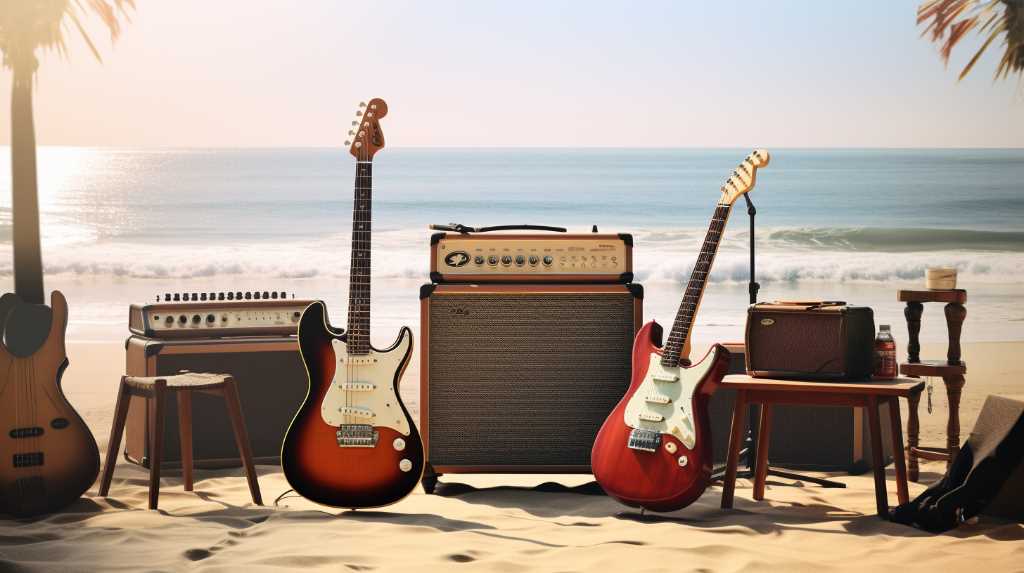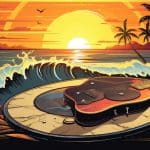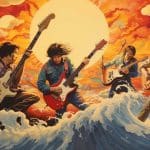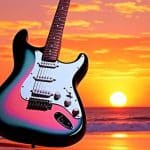
Surf rock, which started in the early ’60s, is famous for its unique sound made by certain instruments. The electric guitar is the star, with its clear, ringing sound made even better by using lots of spring reverb, making it sound like the glint of sunlight on waves. The bass guitar keeps the tunes steady with its beat, while the drums, with their hi-hat and snare, sound like waves hitting the beach. They also use special effects and amps to make the music sound just right.
But to really get why these instruments mix so well and how they came to be, we need to look at the culture of the time. Surf rock’s sound is more than just music; it’s a piece of history, carrying the energy of the time it was born in.
The Electric Guitar’s Role
The electric guitar is really important in surf rock music. It helps create that special sound we all recognize with its twangy notes and smooth slides. The guitar is perfect for making the music sound like the ocean waves that surf rock is all about. Players use different settings on the guitar and a special effect called spring reverb to make it sound like the beach. This isn’t just because it’s always been done this way; the electric guitar can make these cool sounds that really fit with surf music. It does more than just keep the beat; it tells the story of surfing through the sounds it makes.
Let me give you an example: when a guitarist uses a technique called ‘reverb,’ it’s like they’re making the guitar echo in a way that reminds you of the sound of waves crashing. This isn’t just a random choice; it’s a way to take listeners right to the seaside with the music. And because the electric guitar can make so many different sounds, it can capture all the feelings of being on a surfboard, like excitement and freedom. It’s not just playing music; it’s like the guitar is talking to you.
In short, the electric guitar isn’t just another instrument in surf rock. It’s the key to making that beachy vibe come to life.
Bass Guitar Fundamentals
While the electric guitar provides the iconic twang and melodic voice of surf rock, the bass guitar lays down the foundational rhythms and harmonies that anchor the genre’s distinctive sound.
In surf rock, the bass guitar functions not merely as a timekeeper but as an integral component that complements the rhythmic surf beat with a fluid, walking bass line. This approach to bass playing necessitates a synthesis of technical proficiency and rhythmic acumen, allowing the bassist to articulate both the harmonic framework and the dynamic pulse of the music.
Furthermore, the tonal qualities of the bass in surf rock often demand a clean, warm sound, eschewing excessive distortion for clarity that ensures the bass lines maintain their melodic contour within the ensemble’s texture.
Drumming the Surf Beat
Surf rock drummers play a key role in shaping the music’s sound. Their drumming is like the ocean, with beats that push forward and pull back, mimicking the sea’s rhythm. The surf beat is known for its strong bass drum and quick snare hits, giving the music its energetic feel, which reminds listeners of the chaotic nature of waves. The drummers use cymbals, including the hi-hat and ride, to add sounds similar to waves crashing. Their skill in changing the speed and loudness of their playing adds excitement to the music, like waiting for a wave to break. This drumming is essential because it sets the stage for the guitars to add their melodies.
In surf rock, the drummer’s job is to keep the music moving and to add excitement. For example, when a drummer hits the bass drum quickly and uses fast snare rolls, it can make a song feel as thrilling as surfing on a big wave. This style of drumming is important because it’s not just about keeping a steady beat; it’s about making the listener feel the power and unpredictability of the ocean.
Drummers are the backbone of surf rock, and their beats are what make the guitars’ tunes stand out. Imagine listening to a surf rock song without the drums—it wouldn’t have the same energy or make you think of the surf at all.
Reverb and Amplification
Reverb is a key effect in surf rock music. It makes the music sound like it’s echoing in a big space, similar to the sounds at the sea. This echo effect is not just for style; it’s meant to mimic the natural echoes you hear around the ocean.
Guitar amps with built-in spring reverb, like the Fender Showman and the Fender Reverb, are really important for this music. They use springs to create the echo sounds that are so typical of surf rock.
When you turn up the volume on an amp, it doesn’t just make the sound louder. It also changes the sound’s quality, making the echo effect even more noticeable and giving surf rock its special feel.
Miscellaneous Percussion Elements
Surf rock music isn’t just about the echoing sound of guitars; it also uses many different percussion instruments to make its rhythm complex and interesting. These instruments are key to making the unique sound of surf rock. The main beats come from a drum set, but other percussion adds more flavor.
For example, bongos and congas bring in lively beats from Afro-Cuban music. Tambourines shake along with the music, making it feel more alive. There’s also the vibraslap, which makes a unique sound that adds to the fun, quirky feel of surf rock. These extra percussion sounds help create a feeling that matches the excitement of surfing and the sea.
Let’s break it down: The drum set is like the heartbeat of the song. But what really spices things up are the bongos and congas. Think of the bongos as the quick, happy taps you hear, while the congas are like deeper, dance-inspiring beats. The tambourine is the instrument that you might tap your foot to, as it shakes in time with the music. And the vibraslap? It’s that funny, rattling sound that jumps out at you and makes you smile.
Put all these together, and you’ve got a sound that feels like you’re right there at the beach, with the waves crashing and the sun shining.
Conclusion
Surf rock music stands out because of the instruments it uses. The electric guitar has a sharp, twangy sound that catches your ear. The bass guitar keeps a steady rhythm that holds everything together. Drums in surf rock have an upbeat, lively pattern called the surf beat. Reverb, which makes sounds echo, and loud amplifiers also play a big part in making surf rock’s unique sound. Other percussion instruments, like bongos or tambourines, add more layers to the music. These instruments all work together to create what we know as surf rock.
This style of music reminds us of the beach, the feeling of freedom, and the excitement of being young in the 1960s.
For example, if you listen to a classic surf rock song like ‘Misirlou‘ by Dick Dale, you can hear the guitar’s sharp sound and how the reverb makes it echo. It’s a sound that makes you think of waves and surfing. If you’re interested in this type of music and want to try creating it, a Fender Stratocaster guitar with a spring reverb unit would be ideal to get that classic surf rock tone.








